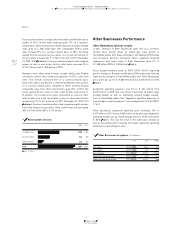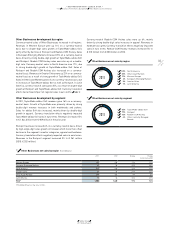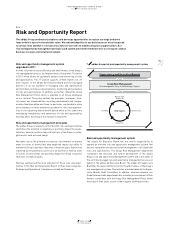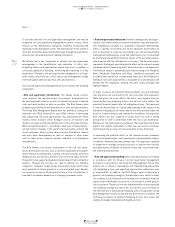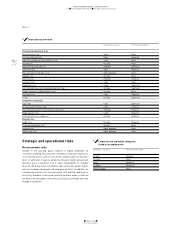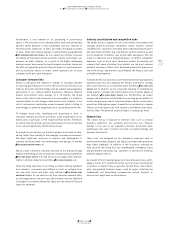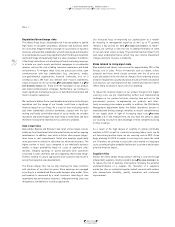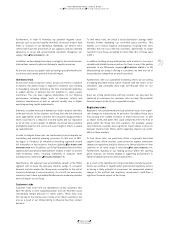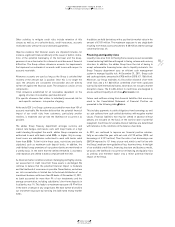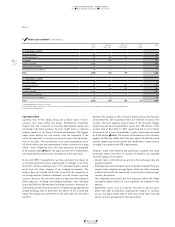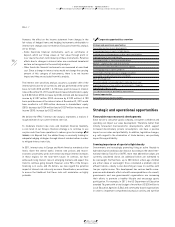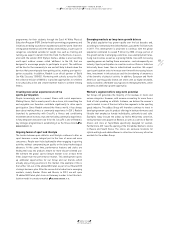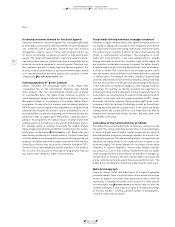Reebok 2011 Annual Report Download - page 156
Download and view the complete annual report
Please find page 156 of the 2011 Reebok annual report below. You can navigate through the pages in the report by either clicking on the pages listed below, or by using the keyword search tool below to find specific information within the annual report.
adidas Group
2011 Annual Report
GROUP MANAGEMENT REPORT – FINANCIAL REVIEW
152
2011
03.4 Risk and Opportunity Report Strategic and operational risks
03.4
Risks related to key event or promotion partnerships
Event and promotion partnerships play an important role in building
brand image and product authenticity with our consumers, and this
ultimately supports the generation of sales
SEE GLOBAL BRANDS STRATEGY,
P. 68
SEE OTHER BUSINESSES STRATEGY, P. 82
. The adidas Group faces the risk of
either losing key partnerships or having to accept unfavourable terms
due to intensified competition for attractive contracts. To mitigate
these inherent risks, we not only seek to extend our most important
partnership agreements before contract expiry, but also to broaden
the Group’s portfolio of premium partnerships to help our brands
expand their consumer reach and reduce our reliance on single affili-
ations. Two examples in 2011 were the extension of the partnership
between adidas and the Spanish Football Federation and Reebok’s
alliance with Swizz Beatz to lead the creative direction of the relaunch
of Reebok’s Classics business.
We also regularly include change-of-control clauses as well as
non-cash compensation components in contracts to avoid the risk
that negotiations are reduced solely to price. We expect a high level of
competition for top promotion partnerships to continue in the near to
medium term as smaller competitors are expected to intensify their
spending in this area.
We also face the risk of misconduct or misbehaviour by our assets
on the one hand and unsatisfying on-field performance of athletes
on the other hand. Therefore, our sports marketing contracts include
clauses which protect us in case of fraudulent, criminal or immoral
behaviour by athletes. We have also secured insurance coverage in
case of athletes’ injuries. In addition, a sophisticated scouting system
enables us to identify the most attractive and relevant sponsorship
assets.
Given the maturity profile of our most important promotion contracts
and the vast portfolio of partnerships, we believe the overall risk
related to key event or promotion partnerships is possible. We assess
the potential financial impact of this risk to be significant in the
medium term.
Product innovation and development risks
Innovative and attractive products generate strong sales and, more
importantly, create a halo effect for other products. Furthermore,
fulfilling highest standards in terms of product quality and safety is
critical to sustainable commercial success and forms an integral part
of the product design and development phase. The speed with which
new product technologies and fresh designs are brought to market
is decisive for maintaining competitive advantage. In 2011, all brands
generated the majority of their sales with products which had been
brought to market over the previous 12 to 18 months
SEE RESEARCH
AND DEVELOPMENT, P. 95
. If the adidas Group failed to maintain a pipeline of
new innovative products over a sustained period of time, we would
risk a significant sales decline. We are committed to pursuing our
innovation and design strength. To ensure we can quickly adapt to
changing consumer preferences, we focus on streamlining research
and development processes to speed up the time to market.
We continue to assess the likelihood of occurrence of risks from
product innovation and development as possible. Given the broad
spectrum of the adidas Group’s product offering, on an aggregate
level, we continue to rate the potential financial impact as minor.
Personnel risks
Achieving the adidas Group’s goal of becoming the global leader in
the sporting goods industry is highly dependent on our employees
and their talents. The loss of key personnel in strategic positions is
therefore an obvious risk we face. We also face the risk of being unable
to identify, recruit and retain the most talented people who best meet
the specific needs of our Group. In addition, a lack of sufficient training
measures might cause the dilution of critical knowledge, in particular
within the product design and development area.
To reduce this risk, we strongly engage in developing a motivating
working environment. Our goal is to make the adidas Group the
“employer of choice” within our industry. Attractive reward and
incentive schemes are designed to further support long-term career
opportunities and planning
SEE EMPLOYEES, P. 101
.
With the expansion of our own-retail activities and the increase of
our employee base in emerging markets, we believe that employee
turnover will slightly increase in the future. Moreover, labour markets
are becoming increasingly more competitive, with the battle for the
most talented employees constantly intensifying.
Therefore, we continue to assess the likelihood of occurrence of
personnel risks as likely. If they materialise, these risks could have a
moderate financial impact on our Group.
IT risks
Key business processes including product marketing, order
management, warehouse management, invoice processing, customer
support and financial reporting are all dependent on IT systems.
A significant systems outage or loss of data could result in consid-
erable disruptions to our business. Insufficient project management
could delay the execution of projects critical to the Group or make
them more expensive than planned. Virus or malware attacks could
also lead to systems disruption and may result in the loss of business-
critical and/or confidential information.


